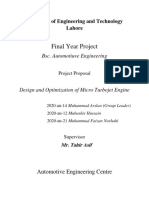The Turbomachinery and Heat Transfer Branch at NASA Glenn Research Center
Uploaded by
Paul VasquezThe Turbomachinery and Heat Transfer Branch at NASA Glenn Research Center
Uploaded by
Paul VasquezThe Turbomachinery and Heat Transfer Branch at NASA Glenn
Research Center
The Turbomachinery and Heat Transfer Branch was formed in the fall of 2005 by the
merger of the Compressor and Turbine branches. The branch conducts fundamental and
applied research to advance the state of the art in turbomachinery for gas turbine
engines, pumps for rocket engines, and heat transfer for aerospace applications.
The research is applicable to civil and military aircraft, industrial engines, and space
vehicles. The research has also been applied to such diverse applications as automotive
fans, vacuum cleaner impellers, and jet ski impellers.
The branch maintains and operates several large test facilities. These facilities are used
to:
← Produce highly detailed test data for validation of computational fluid dynamics
(CFD) codes.
← Measure the performance of advanced compressor and turbine designs.
← Investigate new concepts for improving the performance or stability of
compressors.
← Measure surface heat transfer on turbine blades.
← Study the effects of roughness, transition, and turbulence on turbine heat
transfer.
The branch also develops, maintains, supports, and applies several computational fluid
dynamics (CFD) codes. The codes are applicable to many types of turbomachinery,
including fans, compressors, turbines, pumps, and diffusers. The codes are used to:
← Design advanced turbomachinery.
← Predict turbomachinery performance.
← Understand steady and unsteady flow phenomena in turbomachinery.
← Investigate new concepts for improving the performance or stability of
turbomachinery.
← Predict the effects of advanced turbine cooling configurations.
Curator: Barb Lucci
You might also like
- Literature Review On CFD Application For Helical Coil Heat Exchanger DesignNo ratings yetLiterature Review On CFD Application For Helical Coil Heat Exchanger Design5 pages
- Designing High Performance Steam Turbines With Rotordynamics As A Prime ConsiderationNo ratings yetDesigning High Performance Steam Turbines With Rotordynamics As A Prime Consideration20 pages
- Turbomachinery Laboratory: Continuing Education and Professional Development Undergraduate and Graduate EducationNo ratings yetTurbomachinery Laboratory: Continuing Education and Professional Development Undergraduate and Graduate Education3 pages
- [21]gas turbine engine航空发动机传热_20241-s2.0-S1359431123015521-mainNo ratings yet[21]gas turbine engine航空发动机传热_20241-s2.0-S1359431123015521-main24 pages
- Driving Expander Technology: Atlas Copco Gas and Process Solutions100% (5)Driving Expander Technology: Atlas Copco Gas and Process Solutions24 pages
- Computational Fluid Dynamics: Modelling of A Building FireNo ratings yetComputational Fluid Dynamics: Modelling of A Building Fire1 page
- In-Cylinder Flow Control in A Four-Valve Spark Ignition Engine: Numerical and Experimental Steady Rig TestsNo ratings yetIn-Cylinder Flow Control in A Four-Valve Spark Ignition Engine: Numerical and Experimental Steady Rig Tests16 pages
- Axial Flow Turbine Aerodynamic Shape DesignoptimizationNo ratings yetAxial Flow Turbine Aerodynamic Shape Designoptimization11 pages
- 2005-Guo, Zenglin-App of CFD For Rotating machinery-HD, HS Bearings - SFDNo ratings yet2005-Guo, Zenglin-App of CFD For Rotating machinery-HD, HS Bearings - SFD7 pages
- Shell and Tube Heat Exchanger Design Using CFD ToolsNo ratings yetShell and Tube Heat Exchanger Design Using CFD Tools4 pages
- Atlas Copco Gas and Process Expander BrochureNo ratings yetAtlas Copco Gas and Process Expander Brochure19 pages
- Design and Analysis of Annular Combustion Chamber For A Low Bypass Turbofan Engine in A Jet Trainer AircraftNo ratings yetDesign and Analysis of Annular Combustion Chamber For A Low Bypass Turbofan Engine in A Jet Trainer Aircraft12 pages
- Structural Analysis of Micro Turbine by Using CFD Dr.R.Rajappan, K ChandrasekarNo ratings yetStructural Analysis of Micro Turbine by Using CFD Dr.R.Rajappan, K Chandrasekar8 pages
- CFD Analysis For Estimation of Efficiency of Low-Pressure Steam TurbineNo ratings yetCFD Analysis For Estimation of Efficiency of Low-Pressure Steam Turbine4 pages
- Application of CFD For Analysis and Design of IC EnginesNo ratings yetApplication of CFD For Analysis and Design of IC Engines56 pages
- Computational Fluid Dynamics Analysis of Cryogenic Turboexpander-Ijaerdv03i1016292 PDFNo ratings yetComputational Fluid Dynamics Analysis of Cryogenic Turboexpander-Ijaerdv03i1016292 PDF3 pages
- Design Analysis and Fabrication of Radiators100% (1)Design Analysis and Fabrication of Radiators49 pages
- CFD Simulation of Turbulent Flow in Industrial HeatNo ratings yetCFD Simulation of Turbulent Flow in Industrial Heat6 pages
- PRELIMINARY DESIGN OF A COMBUSTION CHAMBER FORNo ratings yetPRELIMINARY DESIGN OF A COMBUSTION CHAMBER FOR12 pages
- DESIGN_AND_ANALYSIS_OF_TURBINE_BLADES_FOR_TURBOJET_ENGINE_ijariie24590No ratings yetDESIGN_AND_ANALYSIS_OF_TURBINE_BLADES_FOR_TURBOJET_ENGINE_ijariie245908 pages
- Summary Review on the Application of Computational Fluid Dynamics in Nuclear Power Plant DesignFrom EverandSummary Review on the Application of Computational Fluid Dynamics in Nuclear Power Plant DesignNo ratings yet
- Gas-Engines and Producer-Gas Plants A Practice Treatise Setting Forth the Principles of Gas-Engines and Producer Design, the Selection and Installation of an Engine, Conditions of Perfect Operation, Producer-Gas Engines and Their Possibilities, the Care of Gas-Engines and Producer-Gas Plants, with a Chapter on Volatile Hydrocarbon and Oil EnginesFrom EverandGas-Engines and Producer-Gas Plants A Practice Treatise Setting Forth the Principles of Gas-Engines and Producer Design, the Selection and Installation of an Engine, Conditions of Perfect Operation, Producer-Gas Engines and Their Possibilities, the Care of Gas-Engines and Producer-Gas Plants, with a Chapter on Volatile Hydrocarbon and Oil EnginesNo ratings yet



























































